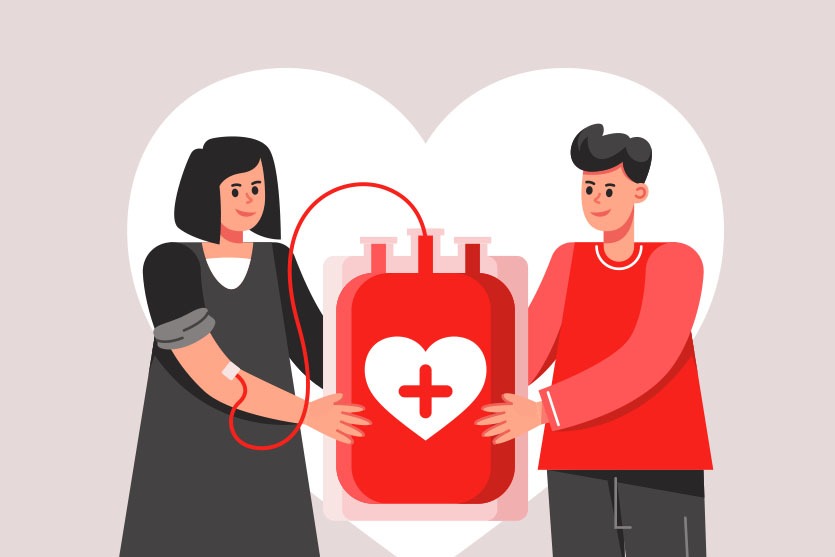
Donating Blood and Its Importance
Have you ever wondered about the significance of blood donation? Does it negatively impact the body’s overall health, and how does the body compensate for the lost quantity during the donation process? Can anyone donate blood, and is the donation process itself painful? All these inquiries will be addressed in the following article.
Blood donation stands as a crucial and noble humanitarian act that contributes significantly to saving thousands of lives every year, especially in cases of accidents and various medical procedures. Blood, being an essential element for life, is imperative for diverse medical procedures such as surgeries, major operations, childbirth, and emergencies.
Benefits of Blood Donation
Blood donation offers numerous health benefits to the donor, including:
- Stimulating Bone Marrow to Produce New Blood Cells: Donating blood stimulates the bone marrow to generate new blood cells, improving blood health and circulation.
- Boosting Circulatory Activity: Blood donation aids in activating the circulatory system and enhancing blood flow throughout the body.
- Reducing the Risk of Cardiovascular Diseases and Blood-related Cancers: Studies have shown that individuals who donate blood at least once a year are less prone to cardiovascular diseases, blood vessel conditions, and blood-related cancers.
- Saving Lives: Blood donation directly contributes to saving the lives of numerous individuals each year. People undergoing surgeries or facing serious accidents often require blood transfusions. Additionally, severe conditions like sickle cell anemia or thalassemia necessitate regular blood transfusions.
- Lowering Iron Levels in the Blood: By reducing excess iron, blood donation may decrease the risk of heart diseases and artery blockages. While the body needs iron to produce red blood cells, storing excessive iron in various organs, such as the liver and heart, might affect their functions.
Individuals affected by Hemochromatosis, a condition involving excessive iron accumulation, benefit from phlebotomy, a process similar to blood donation, to remove excess iron from the body.
Therefore, blood donation serves as a crucial therapeutic option for those with Hemochromatosis. It improves their health, safeguards bodily functions, and saves lives by providing blood to patients in need.
- Enhancing Self-Satisfaction: Blood donation can be an immensely fulfilling experience, providing donors with a sense of satisfaction by helping others. Reports suggest that donating one unit of blood can potentially save the lives of approximately three individuals.
- Monitoring Overall Body Health: Before blood donation, a physical examination and blood tests are conducted on the donor, which can detect conditions like anemia, high or low blood pressure, among others.
What are the types of blood donation?
There are four main types of blood donation:
- Whole blood donation: This type includes all blood components (red cells, plasma, and platelets). It’s the most common type in blood donation processes.
- Platelet donation: This type includes only platelets. They are crucial for blood clotting and preventing bleeding.
- Plasma donation: This type includes only plasma. It’s necessary for transferring antibodies, hormones, and other substances.
- Red blood cell donation: This type includes only red blood cells. They are vital for transporting oxygen throughout the body.
What are the requirements for blood donation?
Any healthy individual in good health can donate blood, provided they meet the following conditions:
- Age between 18 and 65 years.
- Weighing at least 50 kilograms.
- Hemoglobin levels within the normal range, i.e., 14 to 17 grams per deciliter for men, and 12 to 14 grams per deciliter for women.
- Resting heart rate between 50 and 100 beats per minute.
- Body temperature not exceeding 37 degrees Celsius.
- Blood pressure below 120/80 millimeters of mercury.
How is the blood donation process conducted?
Blood donation can be done at any blood donation center. Typically, the process takes about 30 minutes and is entirely painless.
The blood donation process involves the following steps:
- Registration and medical examination.
- Blood withdrawal.
- Resting period after blood donation.
Tips before blood donation
- Drink plenty of fluids before donating blood.
- Ensure adequate rest the night before donating blood.
Tips after blood donation
- Avoid strenuous physical activity or heavy lifting for 5 hours after donation. This helps reduce the risk of dizziness or fainting.
- Drink plenty of fluids, such as water or juice, to replenish lost fluids during donation.
- When feeling dizzy, it’s recommended to lie on your back with raised legs.
- Have a light meal after blood donation and leave the location after 10 minutes.
Some Cases Ineligible for Blood Donation
There are certain individuals who cannot donate blood due to health or medical reasons. These categories include:
- Individuals under 18 years old: Children and teenagers require time for their immune systems to grow and develop, thus they cannot safely donate blood.
- People with infectious diseases like HIV/AIDS, Hepatitis B or C, syphilis, or malaria. Since these diseases can be transmitted through blood, it’s crucial not to donate blood if infected.
- Individuals with hereditary blood disorders such as sickle cell anemia or thalassemia. Transfusing blood with these conditions can lead to serious complications, hence it’s important not to donate if affected.
- Those suffering from severe anemia. When the body lacks enough healthy red blood cells, severe anemia poses risks if blood is donated, so it’s crucial not to donate in this condition.
- People with chronic conditions like diabetes, high blood pressure, or cancer. These conditions can affect blood health, requiring consultation with a doctor before blood donation.
When can one donate blood again?
Blood donation is an entirely safe procedure, ensuring the necessary precautions for the donor’s safety.
- Interval between donations: There should be a minimum of eight weeks between each blood donation to allow the body to replenish the donated blood cells. Donations should not exceed five times per year.
- Potential risks: Some donors may experience mild symptoms post-donation, such as dizziness, fatigue, or bruising at the blood draw site. However, these symptoms typically fade within a few hours.
- Safety measures: All blood donations are conducted by a well-trained medical team, using single-use blood bags and needles for each donor. Hence, donors are not at risk of any infection through the blood donation process.
Blood donation is a safe and straightforward procedure, primarily a humanitarian act that contributes to saving thousands of lives worldwide annually. If you’re in good health, consider donating blood today to improve your health and contribute to saving others’ lives.









Hello
February 15, 2025OsyTr ueFU WplyfLk qTESUayO eSa ytHNRD HsVnG